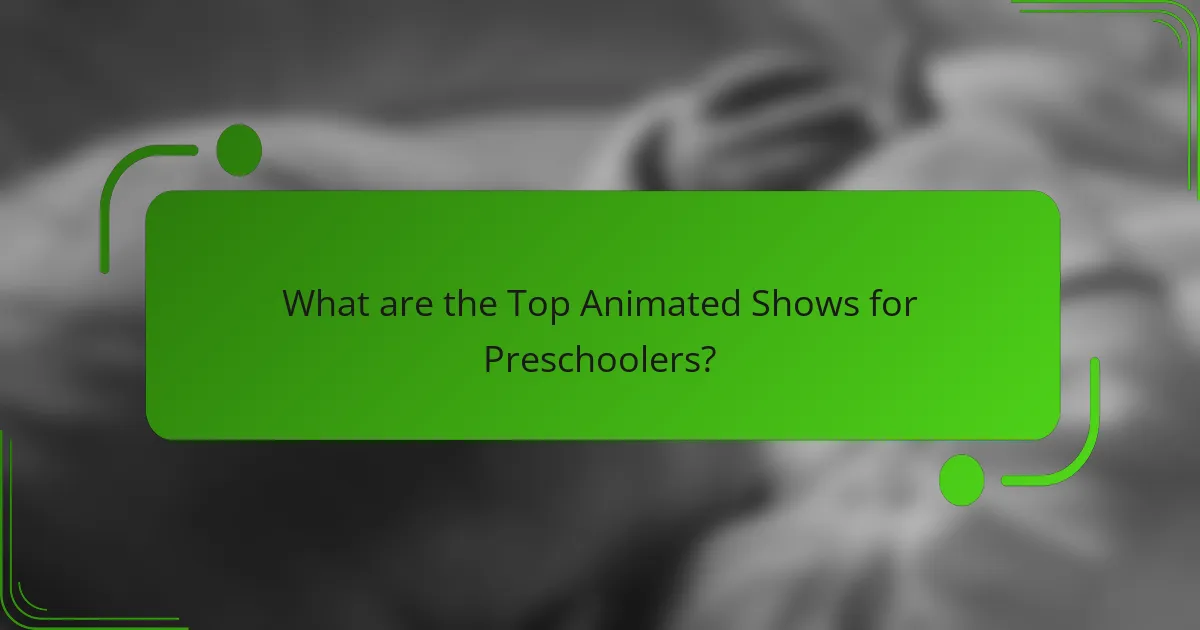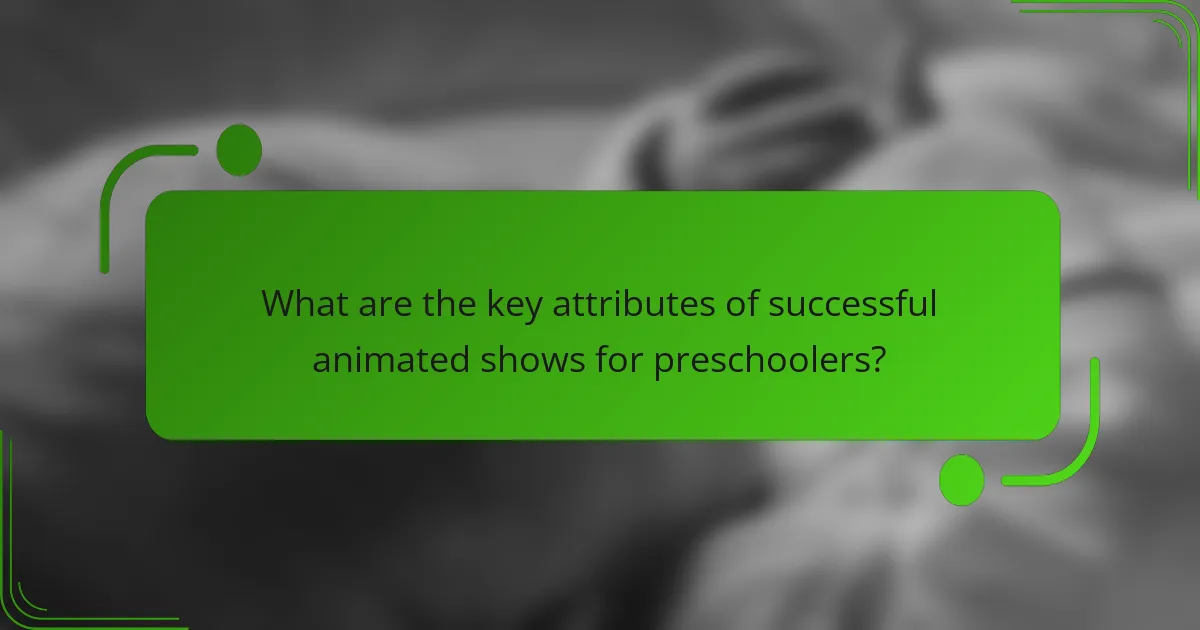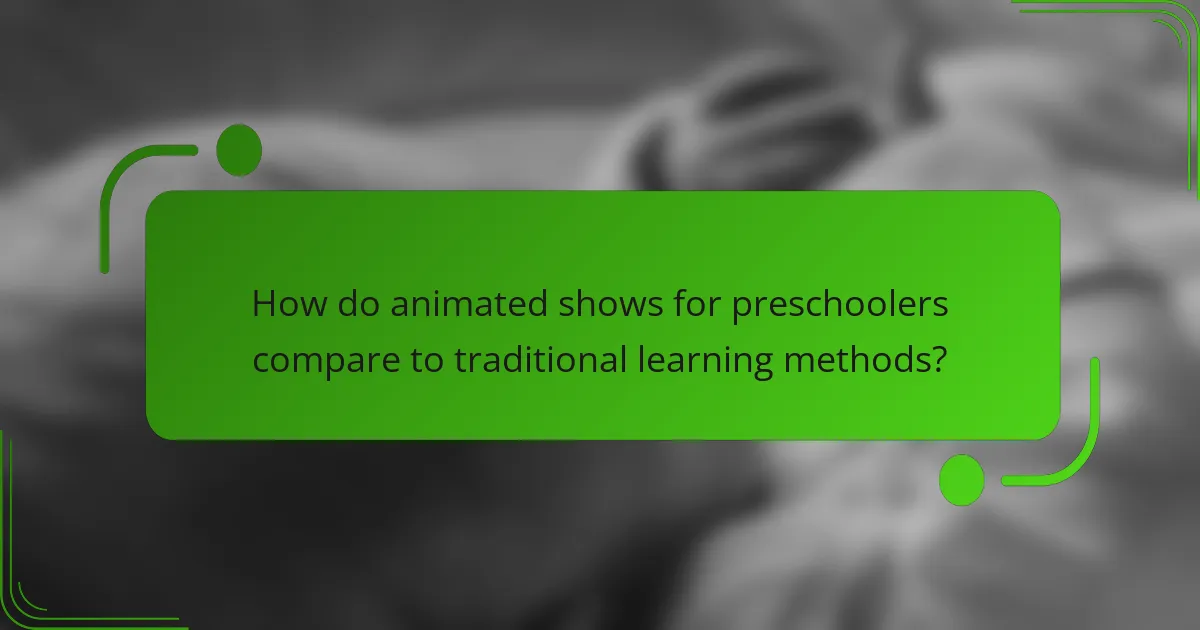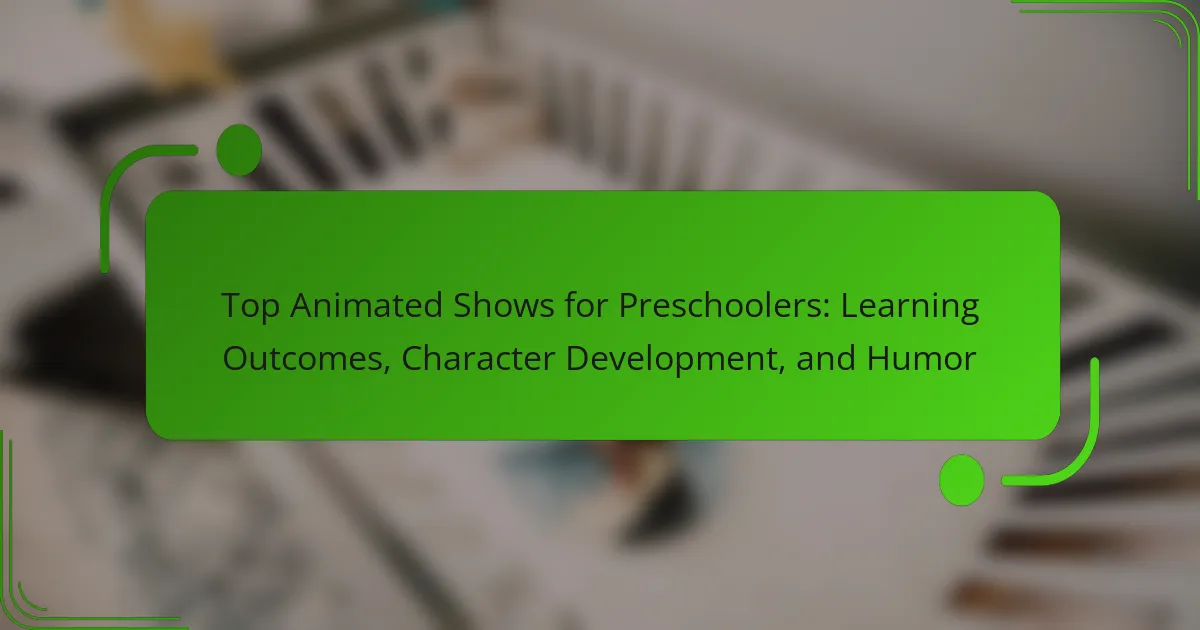The article focuses on the top animated shows for preschoolers, highlighting five key programs: “Paw Patrol,” “Peppa Pig,” “Bluey,” “Daniel Tiger’s Neighborhood,” and “Sesame Street.” Each show is examined for its educational value, including themes of teamwork, family values, creativity, emotional intelligence, and foundational literacy skills. The article discusses how these shows engage young audiences through relatable characters, age-appropriate humor, and vibrant visuals, enhancing learning and retention. Additionally, it emphasizes the importance of interactive elements and character interactions in promoting social skills and cognitive development. Research findings support the effectiveness of these animated programs in providing a dynamic learning experience that complements traditional educational methods.

What are the Top Animated Shows for Preschoolers?
The top animated shows for preschoolers include “Paw Patrol,” “Peppa Pig,” “Bluey,” “Daniel Tiger’s Neighborhood,” and “Sesame Street.” “Paw Patrol” teaches teamwork and problem-solving. “Peppa Pig” focuses on family values and social skills. “Bluey” encourages imagination and creativity through play. “Daniel Tiger’s Neighborhood” promotes emotional intelligence and kindness. “Sesame Street” offers foundational literacy and numeracy skills. These shows are popular for their engaging content and educational value. They have received positive reviews from parents and educators alike for their ability to entertain while teaching essential life skills.
How do these shows contribute to early childhood development?
Top animated shows for preschoolers contribute to early childhood development by enhancing cognitive skills, social-emotional growth, and language acquisition. These shows often incorporate educational themes, which help children learn basic concepts like numbers and letters. Research indicates that children who watch educational programming perform better in school readiness assessments. For example, a study published in the Journal of Educational Psychology found that children who engaged with educational shows showed improved vocabulary and comprehension skills. Additionally, these shows often depict social interactions, teaching children about empathy, sharing, and teamwork. Engaging storylines and relatable characters promote emotional intelligence and problem-solving abilities. Overall, these animated shows serve as valuable tools in fostering essential developmental milestones during early childhood.
What specific learning outcomes can preschoolers achieve from these shows?
Preschoolers can achieve various specific learning outcomes from animated shows. These outcomes include enhanced vocabulary and language skills through dialogue and storytelling. Shows often introduce new words and concepts in context, aiding comprehension. Additionally, preschoolers develop social skills by observing character interactions and resolving conflicts. They learn about emotions and empathy, understanding how characters feel in different situations. Cognitive skills are also fostered, as many shows present problem-solving scenarios. Furthermore, preschoolers gain foundational knowledge in subjects like math and science through engaging content. Research indicates that educational shows can significantly improve early literacy and numeracy skills in young children.
How do these shows promote social skills among preschoolers?
Animated shows promote social skills among preschoolers by modeling positive interactions. Characters often demonstrate sharing, cooperation, and empathy. These shows create relatable scenarios that preschoolers can identify with. Children learn to recognize emotions through character expressions and dialogues. Engaging storylines encourage discussions about friendship and conflict resolution. Research shows that children who watch these shows exhibit improved social behaviors. A study by Linebarger and Walker (2005) found that educational programming enhances social understanding in young viewers. This combination of relatable content and emotional learning fosters essential social skills in preschoolers.
What role does humor play in preschool animated shows?
Humor plays a significant role in preschool animated shows by enhancing engagement and learning. It captures children’s attention and makes content more enjoyable. Humor often simplifies complex concepts, making them easier for young viewers to understand. For example, comedic situations can illustrate moral lessons or social interactions effectively. Research indicates that humor in educational contexts improves retention of information. A study by the University of California found that children remember lessons better when humor is included. This demonstrates that humor not only entertains but also facilitates cognitive development in preschoolers.
How does humor enhance engagement in preschoolers?
Humor enhances engagement in preschoolers by capturing their attention and fostering a positive learning environment. It stimulates cognitive development through laughter, which promotes social interaction. Research indicates that humor can improve memory retention in young children. For instance, a study published in the journal “Child Development” found that children exposed to humorous content showed better recall of information. Additionally, humor encourages creativity and problem-solving skills. Engaging with humorous content also helps preschoolers develop emotional intelligence by recognizing emotions in themselves and others. Overall, humor serves as a powerful tool in educational settings for preschoolers.
What types of humor are most effective for preschool audiences?
Physical humor and slapstick are the most effective types of humor for preschool audiences. Preschoolers enjoy visual comedy that involves exaggerated actions and funny sounds. This type of humor is easily understood and relatable for young children. For example, characters slipping on banana peels or making silly faces elicit laughter. Additionally, simple puns and wordplay can also be effective, as they introduce language in a fun way. Research shows that humor enhances cognitive development and social interaction among preschoolers. Studies indicate that laughter during viewing increases engagement and retention of educational content.

What are the key attributes of successful animated shows for preschoolers?
Successful animated shows for preschoolers possess engaging characters, age-appropriate humor, and educational content. Engaging characters captivate young audiences and encourage emotional connections. Age-appropriate humor keeps children entertained while facilitating cognitive development. Educational content promotes learning through fun narratives and interactive elements. Research indicates that shows like “Sesame Street” enhance early literacy and social skills. Animated shows that incorporate music and movement also foster active participation and retention of lessons. Visual appeal, including vibrant colors and animation styles, attracts preschoolers and maintains their interest.
How is character development approached in these shows?
Character development in top animated shows for preschoolers is approached through relatable storylines and consistent character traits. Characters often face challenges that promote problem-solving and emotional growth. These shows frequently emphasize friendship, sharing, and cooperation. Each character typically embodies specific values that resonate with young audiences. For example, a character may represent kindness or bravery. This consistency helps children understand and internalize these traits. Additionally, character arcs often show progression over episodes, reinforcing learning outcomes. Research indicates that this method supports social and emotional development in preschoolers, enhancing their understanding of relationships and empathy.
What traits make characters relatable to preschoolers?
Characters relatable to preschoolers often exhibit traits such as simplicity, emotional expressiveness, and familiarity. Simple traits make it easier for young children to understand and connect with characters. Emotional expressiveness allows preschoolers to see their own feelings reflected in the characters. Familiarity with everyday situations helps preschoolers relate to the characters’ experiences. Additionally, characters that demonstrate kindness and friendship resonate well with preschoolers. Studies show that children relate better to characters who display these traits, enhancing their engagement and learning.
How do character arcs contribute to the storyline?
Character arcs significantly enhance the storyline by providing depth and transformation to characters. They allow characters to evolve in response to conflicts and challenges. This evolution creates emotional engagement for the audience. For example, a character may start as timid and grow into a confident leader. This journey reflects the themes of growth and resilience. Furthermore, character arcs can drive the plot forward by introducing new motivations and conflicts. The audience becomes invested in the characters’ outcomes, which increases overall interest in the storyline. In preschool animated shows, these arcs often teach valuable lessons about friendship and perseverance.
What educational themes are commonly explored in these shows?
Common educational themes explored in top animated shows for preschoolers include social skills, problem-solving, and emotional intelligence. These shows often teach children how to share, cooperate, and communicate effectively with others. They also present scenarios that require critical thinking and decision-making. Emotional intelligence is developed through characters expressing feelings and resolving conflicts. Additionally, many shows incorporate basic academic concepts such as numbers, letters, and shapes. Research indicates that these themes enhance cognitive and social development in young viewers. For example, a study by the American Academy of Pediatrics emphasizes the importance of educational content in fostering early childhood learning.
How do shows incorporate basic concepts like numbers and letters?
Shows incorporate basic concepts like numbers and letters through interactive storytelling and visual aids. Characters often engage in counting games or spelling activities. For example, shows like “Sesame Street” use songs and animations to teach these concepts. They present numbers and letters in colorful, engaging formats. This approach helps preschoolers recognize and remember them. Research shows that early exposure to these concepts enhances literacy and numeracy skills. Programs designed for young children often include repetition and reinforcement of these ideas. This method supports cognitive development and makes learning enjoyable.
What life lessons are frequently taught through storytelling?
Storytelling frequently teaches life lessons such as empathy, resilience, and the importance of honesty. These lessons are conveyed through characters’ experiences and challenges. For example, stories often illustrate how understanding others’ feelings fosters compassion. Resilience is demonstrated when characters overcome obstacles, showing the value of perseverance. Honesty is highlighted through consequences faced by characters who lie. Research indicates that narratives can enhance moral reasoning and social understanding in children. This is supported by studies from the Journal of Educational Psychology, which show that storytelling improves empathy and ethical decision-making skills.

How do animated shows for preschoolers compare to traditional learning methods?
Animated shows for preschoolers enhance learning through engagement and interactivity. They often use vibrant visuals and relatable characters to capture children’s attention. This approach can lead to improved retention of information compared to traditional methods like textbooks. Research shows that preschoolers learn better when concepts are presented in a fun and entertaining format. For instance, a study published in the journal “Child Development” found that children who watched educational cartoons performed better on tests than those who learned from traditional materials. Animated shows also promote social skills through character interactions, which traditional methods may lack. Overall, animated shows provide a dynamic learning experience that complements traditional education.
What advantages do animated shows offer over classroom learning?
Animated shows offer engaging and interactive learning experiences that surpass traditional classroom methods. They utilize visual storytelling to capture attention and enhance retention. This format caters to various learning styles, particularly visual and auditory learners. Animated content often simplifies complex concepts through relatable characters and narratives. Research indicates that children retain information better when it is presented in an entertaining format. For example, a study by the University of California found that children who watched educational cartoons performed better on knowledge retention tests compared to those who learned through lectures. Animated shows also foster emotional connections, making learning more relatable and enjoyable. This emotional engagement can lead to a deeper understanding of the material.
How do these shows support different learning styles?
These shows support different learning styles by incorporating various teaching methods. Visual learners benefit from colorful animations and illustrations. Auditory learners engage with songs and dialogue that reinforce concepts. Kinesthetic learners are encouraged to participate in activities and movement-based learning. These diverse approaches cater to children’s individual preferences. Research indicates that varied instructional strategies enhance comprehension. For example, a study by the National Association for the Education of Young Children found that multimedia resources improve engagement and retention in preschoolers. Thus, these animated shows effectively address multiple learning styles.
What evidence exists to support the effectiveness of animated learning?
Animated learning is effective for enhancing comprehension and retention. Research shows that animations can improve understanding of complex concepts. A study by Hegarty and Kozhevnikov (2009) found that animated visuals significantly aid learning compared to static images. Another study by Moreno and Mayer (2002) highlighted that students using animation scored higher on tests than those who did not. The dynamic nature of animations captures attention and aids memory recall. This evidence supports the notion that animated learning is beneficial in educational contexts.
What should parents consider when choosing animated shows for their preschoolers?
Parents should consider educational value when choosing animated shows for their preschoolers. Shows should promote learning through engaging storytelling and relatable characters. Content should be age-appropriate and free from violence or inappropriate themes. Parents should also evaluate the show’s ability to foster social skills and emotional intelligence. Positive role models within the show can encourage good behavior and problem-solving. Additionally, animation quality and visual appeal can enhance engagement. Parents should look for shows that incorporate humor to make learning enjoyable. Research indicates that educational programming can significantly impact early childhood development.
How can parents assess the educational value of a show?
Parents can assess the educational value of a show by analyzing its content and objectives. They should consider whether the show promotes critical thinking, problem-solving, and social skills. Parents can review the curriculum goals associated with the show. They can also look for expert reviews or educational ratings from trusted sources. Observing their child’s engagement and learning outcomes while watching the show is essential. Research shows that quality educational shows can enhance vocabulary and cognitive skills in preschoolers. Parents can also seek feedback from educators about the show’s effectiveness in promoting learning.
What are the recommended viewing times for preschoolers?
The recommended viewing time for preschoolers is one hour per day. This guideline is supported by the American Academy of Pediatrics. They suggest that children aged 2 to 5 should have limited screen time. Engaging in other activities is essential for their development. These activities include play, reading, and social interaction. Excessive screen time can lead to negative health effects. It can impact sleep, behavior, and learning. Therefore, balancing screen time with other activities is crucial for preschoolers.
What are some tips for maximizing the learning experience from animated shows?
To maximize the learning experience from animated shows, actively engage with the content. Discuss the themes and characters with children after watching. Ask open-ended questions to encourage critical thinking. Incorporate related activities, such as drawing or role-playing. Use educational resources that complement the show’s content. Monitor the child’s reactions to identify areas of interest. Choose shows that align with learning goals. Research indicates that interactive viewing boosts comprehension and retention.
How can parents engage with their preschoolers during viewing?
Parents can engage with their preschoolers during viewing by asking questions about the show. This encourages critical thinking and comprehension. They can also point out characters’ emotions and actions. Discussing these elements helps children connect with the story. Additionally, parents can participate in activities related to the show’s themes. This reinforces learning and creativity. Sharing personal experiences related to the content can deepen understanding. Setting limits on screen time promotes balance in viewing habits. Research shows that active engagement enhances learning outcomes for preschoolers.
What follow-up activities can enhance the lessons learned from the shows?
Follow-up activities that can enhance the lessons learned from the shows include interactive discussions and creative projects. Engaging children in conversations about the show’s themes reinforces their understanding. Parents and educators can ask open-ended questions to stimulate critical thinking.
Art projects related to the show’s characters or stories can encourage creativity and expression. Role-playing activities allow children to explore character motivations and consequences. Storytelling sessions can help children articulate their thoughts and feelings about the show’s content.
Additionally, incorporating music or movement related to the show can enhance memory retention. These activities have been shown to deepen comprehension and foster a love for learning.
Top Animated Shows for Preschoolers highlights popular programs like “Paw Patrol,” “Peppa Pig,” “Bluey,” “Daniel Tiger’s Neighborhood,” and “Sesame Street,” emphasizing their educational value and contribution to early childhood development. The article explores specific learning outcomes, including vocabulary enhancement, social skills, and emotional intelligence, as well as the role of humor in engaging preschool audiences. It also examines character development, educational themes, and effective viewing practices for parents to maximize learning experiences. The content provides insights into how animated shows can complement traditional learning methods and support various learning styles.
